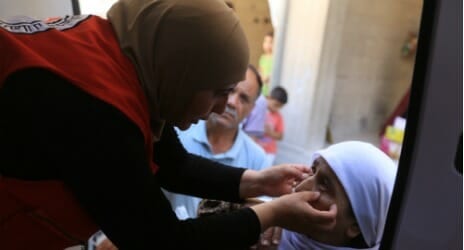By Viviane Tou’meh and Penny Sims in Syria
When the Syrian Arab Red Crescent Mobile Health Unit arrives in Ghuzlaniyah, children run around the vehicle greeting the volunteers with shouts of pleasure. Men and women from the neighbourhood, situated 20 kilometres east of Damascus, start to form queues.
The queues are long – before the crisis, this village housed 3,000 families. Now another 10,000 families have come here.
“This mobile health unit visits the village three times a week, and provides medical consultations for over 120 patients in each visit and sometimes we see as many as 150 patients”, says Dr. Rihab, “sometimes we have to work very late, like during our response to Mouadamiyah in last October, the SARC teams saw so many patients we worked until midnight.”
Away from the crowd of giggling children, 14-year-old Majidah sits in her wheelchair. Majidah no longer wants to take part in the queue or to play; she has other concerns. Her family are displaced and living in poverty, which means they cannot afford the adult diapers she needs. She has come to ask the mobile health unit for help.
Work barriers
“Satisfying people needs is not an easy as you think”, says Dr. Rihab. “We have a challenge when dealing with people, we try to cope with patient requests and understand their needs”, she continues, “Patients sometimes just need somebody to understand them.”
“One challenge we face is our lack of ability to cover all the cases and just to have enough time, where to do adequate tests for a patient requires a long time”, says Dr. Rihab.
“Another challenge is the variety of cases we see”, she continues: “Also with the lack of places to play or even toys, the children play outside with earth, which is filled with germs. This causes skin diseases, such as scabies, psoriasis, other diseases caused by contact with animals, and even typhoid fever. In addition we see sun stroke and bruises as they often cut themselves with shattered glass or other sharp materials scattered in the fields.”
Now the Mobile Health Unit always accompanied by psycho-social support volunteers who do many activities for children, playing games and face-painting.
Hard to stay healthy
As well as a lack of healthcare, the community also lack adequate food and water to help stay healthy.
“This village is inhabited by 3,000 families in addition to 8,500 displaced families who have registered, but the real total number of displaced families is about 10,000”, says Thaer al-Awad, a member of the relief committee, he continues “In winter it will be more worse – the electricity situation is also catastrophic”.
According to Mr. Awad, no water resources exist in this area. The Syrian Arab Red Crescent is trying to address this concern. A local official explains that they only have running water for 3 hours every 20 days, so people have to buy water from tankers. Prior to the crisis, this area was already suffering water shortages and its wells had dried.
“We have suggested a project proposal for three groundwater wells but even so the water of these wells will be sulphurous water and will have to be treated before being used” Mr. Awad explained.
The municipality of this village coordinates with SARC’s Jaramanah sub-branch in order to organise the response to this area.
“We receive 3,200 food parcels each month, thus, approximately each family receives one food parcel each two and a half months”, Mr. Awad explained. “Children are living in incomplete buildings or gathering camps and their families are struggling”.
[g_slider source=”media: 262,261,260″ limit=”2″ link=”lightbox”]



Discussion about this post